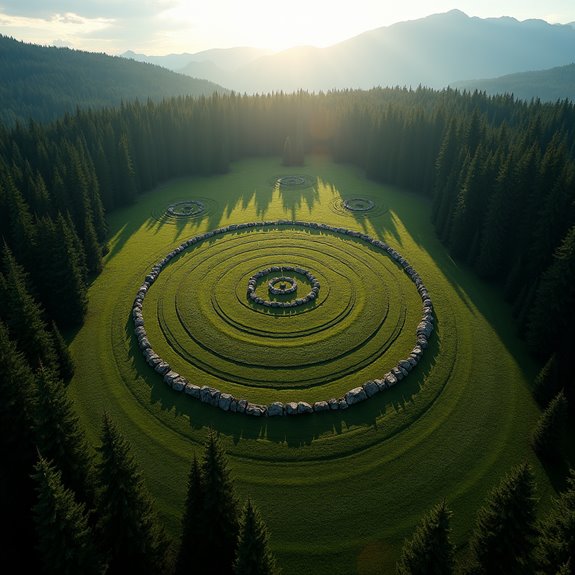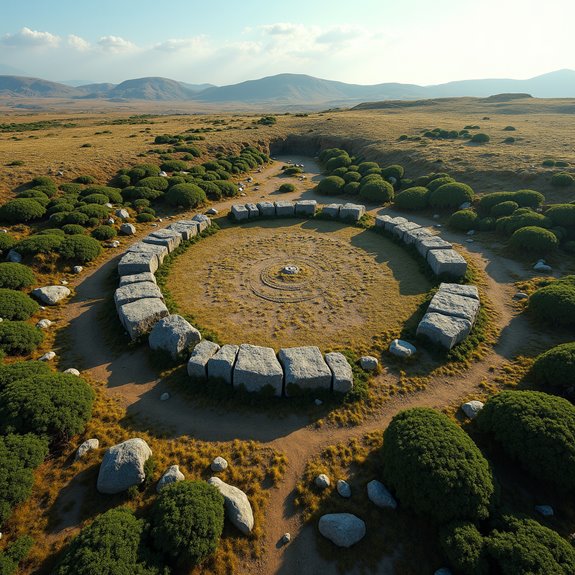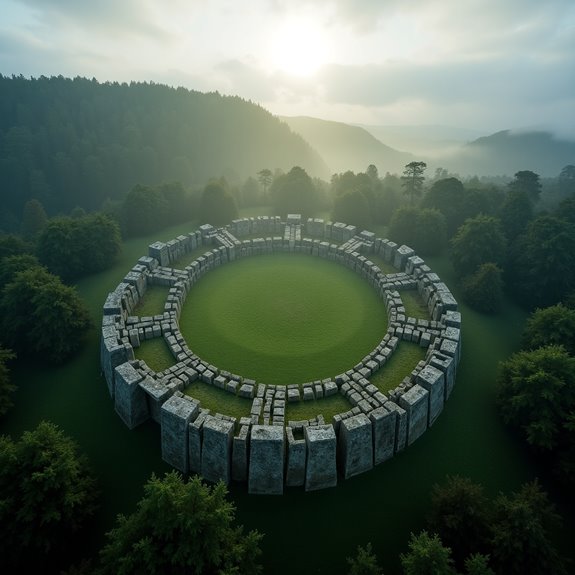Did Ancient Giants Build Mysterious Stone Circles in North America?
The notion that ancient giants constructed the enigmatic stone circles in North America is a fascinating topic. Legends often paint these giants as formidable beings, yet archaeological findings suggest a different narrative. Early civilizations displayed remarkable skill and knowledge, utilizing advanced techniques to create these structures. This raises questions about the blending of myth and reality. What might the true story reveal about our ancestors’ understanding of the cosmos and their ritualistic practices?
Introduction

While myths of ancient giants have captivated human imagination for centuries, the mysterious stone circles scattered across various landscapes hint at a deeper connection to these legends. Many people wonder if these enigmatic structures, often aligning with astronomical phenomena, could bear witness to the existence of colossal beings. Legends describe giants as skilled builders, capable of moving enormous stones that modern engineering struggles to comprehend. Some historians speculate these circles served as ceremonial sites, linking humanity to beings of greater stature. As researchers uncover more about these ancient constructions, they fuel curiosity about who really created them. The close relationship between the mythology of giants and the presence of stone circles continues to inspire exploration and investigation into the historical truths hidden beneath the soil.
Ancient Civilizations and Stone Circles

As ancient civilizations rose and thrived across the globe, their connection to stone circles reveals much about their cultural practices and beliefs. These structures often served as ceremonial grounds, marking important astronomical events or seasonal festivals. For many societies, the stones embodied spiritual significance, acting as symbols of community identity and unity. The construction techniques and arrangements varied, reflecting the unique environmental and cultural contexts of each civilization. Furthermore, the alignment of these circles with celestial bodies underscores a sophisticated understanding of astronomy among ancient peoples. By analyzing these stone circles, researchers gain insights into the social, religious, and agricultural practices of the time, illuminating how these ancient communities interacted with their environment and each other.
Notable Cases or Sightings

Stone circles have captured attention not only for their historical significance but also for intriguing reports and sightings around these ancient sites. Many visitors have claimed to experience strange phenomena, like sudden temperature drops or feelings of unease when near certain circles. In Vermont, locals reported seeing glowing lights hovering over a stone circle at night, igniting curiosity and speculation about their origins. Similarly, a group of hikers in Montana described hearing distant chanting near the Medicine Wheel, prompting theories about ancient rituals. In both cases, these accounts fueled fascination with the possibility of ancient giants having constructed these monumental structures. Such sightings add an air of mystery to the stone circles, inviting further investigation into their true purpose and history.
Common Theories or Explanations
Many researchers propose various theories to explain the purpose and construction of stone circles, believing they served significant cultural or astronomical functions in ancient societies. Some experts assert that these formations acted as calendars, marking solstices and equinoxes, while others suggest they were ritualistic sites for ceremonies. Anthropologists point out potential links to social organization, viewing stone circles as gathering places for clan meetings or festivals. Additionally, some propose that ancient communities built these structures for navigational purposes, using their alignments to guide travelers. Finally, there’s a theory suggesting that a prehistoric understanding of geometry and engineering enabled these cultures to construct complex designs, emphasizing their advanced skills despite limited resources. Each theory highlights the rich tapestry of human ingenuity in ancient times.
Frequently Asked Questions
What Methods Do Historians Use to Date These Stone Circles?
Historians typically use radiocarbon dating and dendrochronology to determine the age of stone circles. They analyze organic materials and tree rings, providing insights into the structures’ construction and usage over centuries. This method’s accuracy enhances their understanding.
Are There Any Similarities With Stone Circles in Other Countries?
Historians note interesting similarities between stone circles worldwide, including their alignments and construction techniques. Many ancient cultures utilized similar methods, suggesting shared beliefs. These parallels raise intriguing questions about cultural exchange and human innovation across different civilizations.
How Do Local Tribes View These Stone Circles Today?
Local tribes view these stone circles as sacred sites, embodying their ancestors’ heritage. They believe these structures connect them to the land and their history, reinforcing cultural identity and fostering reverence for their spiritual significance.
What Role Do Modern Technologies Play in Studying These Structures?
Modern technologies like LiDAR and ground-penetrating radar enhance researchers’ understanding of ancient structures. By revealing hidden features and providing precise measurements, they’ve opened new avenues for exploration and interpretation of these enigmatic stone circles.
Have Any Stone Circles Been Scientifically Excavated for Research?
Many stone circles have undergone scientific excavation for research. Archaeologists have explored several sites, uncovering artifacts and features that provide insights into the cultures that constructed these enigmatic structures long ago within various landscapes.


